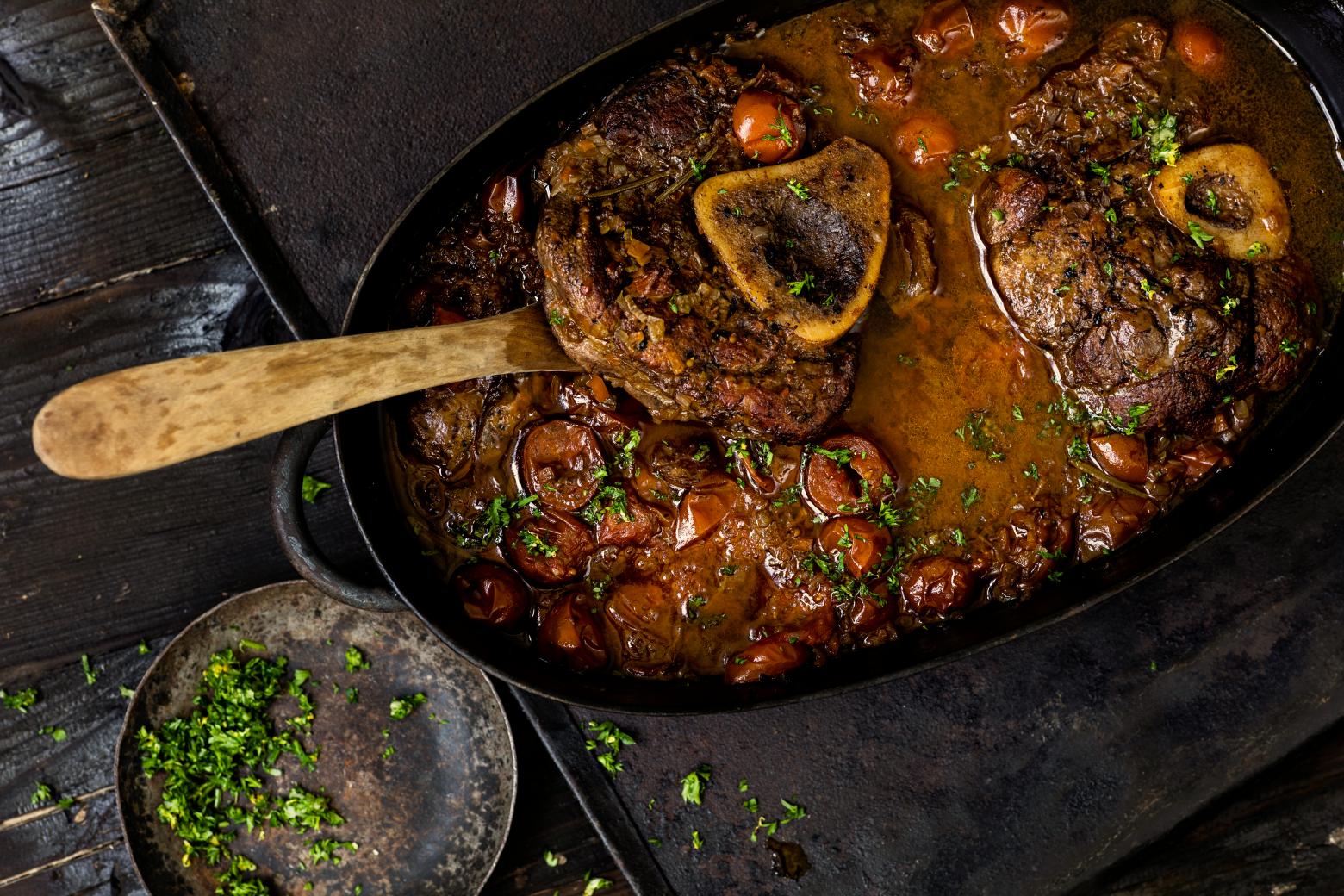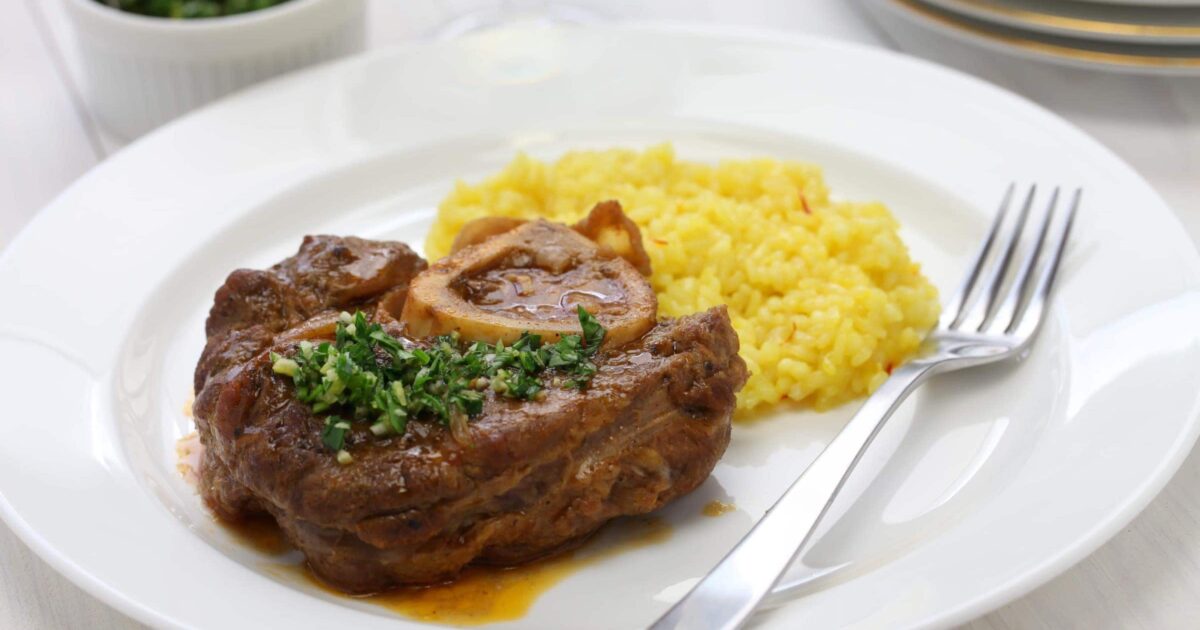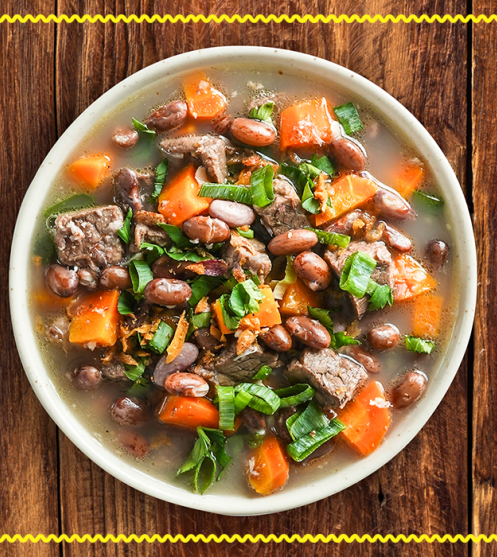The first time I tasted Ossobuco, I was sitting in a tiny Milanese trattoria where the scent of wine, herbs, and slow-braised meat filled the air. The dish came out piping hot, garnished with a fresh gremolata, and served alongside a creamy bed of risotto alla Milanese. One bite, and I understood—this wasn’t just food. This was comfort, elegance, and tradition all simmered into one.
Ossobuco (literally “bone with a hole”) is a classic Northern Italian dish that celebrates slow cooking, rich flavors, and the beauty of using every part of the animal—including the marrow, which melts into the sauce for an unforgettable depth.
🥩 What Is Ossobuco?

Ossobuco is a traditional dish made from cross-cut veal shanks, braised slowly in mixture of:
-
White wine
-
Broth
-
Aromatic vegetables (onion, carrot, celery)
-
Tomatoes
-
Herbs like thyme, bay leaf, and parsley
The center of the veal shank contains a bone with marrow, which is the heart of the dish—rich, buttery, and absolutely worth scooping out with a tiny spoon.
Cooked low and slow, ossobuco becomes fall-off-the-bone tender, with a sauce that’s both silky and robust.
🏛️ The Milanese Origin
This dish hails from Milan, in the Lombardy region of Northern Italy, and has been a staple of local cuisine since at least the 19th century.
Traditionally, Ossobuco alla Milanese is served with:
-
Risotto alla Milanese, infused with saffron
-
Gremolata, a zesty mix of parsley, lemon zest, and garlic added right before serving to brighten the dish
The pairing of the rich veal and creamy saffron risotto is legendary—it’s comfort food with class.
🍳 How Ossobuco Is Made (Traditional Style)
You don’t need to be a professional chef to make great ossobuco at home—you just need time, patience, and a heavy pot.
Step-by-Step:
-
Sear the veal shanks – Dredge in flour and brown in olive oil or butter. Set aside.
-
Sauté aromatics – Onion, carrot, and celery go in next until softened.
-
Deglaze with white wine – Scrape up all those tasty brown bits!
-
Add tomatoes and broth – Return the meat to the pot, add herbs.
-
Simmer low and slow – Cover and cook for 2–3 hours until tender.
-
Finish with gremolata – Sprinkle fresh lemon zest, garlic, and parsley on top just before serving.
✅ Tip: Don’t rush the braise. Let the meat slowly absorb every bit of flavor from the sauce.
🍽️ How to Serve Ossobuco
The most classic pairing:
-
Risotto alla Milanese – Creamy, saffron-colored risotto that soaks up the veal juices
Other options include:
-
Polenta – A rich cornmeal base to catch all the sauce
-
Mashed potatoes – Not traditional, but still excellent
-
Crusty bread – For that final swipe across the plate
No matter what, ossobuco is a dish meant to be shared and savored slowly.
🧠 Did You Know?
-
“Osso buco” means “bone with a hole”, referring to the exposed marrow bone in the veal shank.
-
Veal is traditional, but you’ll also find Ossobuco di Manzo (beef shank) as a more affordable or accessible option.
-
Some regional variations skip the tomato, sticking to wine and broth for a lighter sauce.
🧂 What Makes a Great Ossobuco?
It’s all about balance:
-
Meat should be tender, not stringy
-
Sauce should be thick, glossy, and rich in umami
-
Marrow should be soft, scoopable, and full of flavor
-
Gremolata should cut through the richness like a breath of fresh air
If you can hit those notes? You’ve nailed it.
✅ Final Thoughts: A Celebration of Slow Cooking
Ossobuco is Italian comfort food at its finest—slow-cooked, deeply flavorful, and rooted in tradition. It’s a dish that takes time and care, but the result is always worth it.
Whether you’re making it for a dinner party, Sunday family meal, or just because you want to treat yourself to something truly special, ossobuco delivers every time.
And trust me, once you’ve scooped the marrow onto a bite of saffron risotto… you’ll understand why Italians have been making this for generations.




